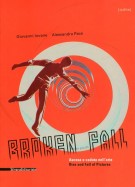Broken Fall Ascesa e caduta nell'arte Rise and Fall of Pictures
| Author(s) | Giovanni Iovane, Alessandra Pace | ||
| Editor | Silvana Editoriale | Place | Milano |
| Year | 2010 | Pages | 160 |
| Measure | 17x24 (cm) | Illustration | 32 ill. a colori, 128 ill. b/n n.t. - colour and b/w ills |
| Binding | bross.ill colori con alette - paperback illustrated | Conservazione | Nuovo - New |
| Language | Italiano/Inglese - Italian/English text | Weight | 1000 (gr) |
| ISBN | 8836618995 | EAN-13 | 9788836618996 |
not available
(Outline).
La paura di cadere è una paura molto antica. Cadere è l’opposto di volare e concettualmente si manifesta attraverso la dialettica della pesantezza, di ciò, e di colui, che cade a terra. Cadere è connesso anche a camminare male, barcollare, saltare, a perdersi e anche a fallire. Nell’esperienza artistica moderna e contemporanea cadere diviene un’azione intenzionale. Un’azione che coinvolge il corpo dell’artista e spesso il destino dell’immagine dell’opera d’arte.
Equilibristi, saltimbanchi, clown, le gags di Chaplin o Buster Keaton, i personaggi aggrappati ai cornicioni o a davanzali dei film di Alfred Hitchcock, il funambolo Philip Petit sospeso fra le torri gemelle di New York, sino alle traiettorie sperimentate da Bruce Nauman o da Bas Jan Ader, sono tutti esempi di figure dell’esperienza artistica legate all’esercizio della caduta. Nello stesso tempo, cadere è anche un’azione legata alla pratica della pittura, ai suoi procedimenti messi in atto nel Novecento, a cominciare dai drippings di Jackson Pollock, sino a tutte quelle opere realizzate con cadute o colature del colore su superfici poste a terra e non più attaccate a un muro.
Broken Fall – secondo volume della collana Outline –, riflette su questa condizione di caduta dell’opera d’arte attraverso una scrittura per immagini e non descrittiva. Una caduta che, dagli inizi del 900, si si rivela come una angosciante e, insieme, brillante, strategia fallimentare.
The fear of falling is as old as mankind. Falling is the symmetrical opposite of flying, and has been pictured according to different conceptions of weight - of the body wich falls to the ground. Falling is also linked to walking badly, staggering, jumping, getting lost, and also to failing. In modern and contemporary art, falling has become an intentional action. An action that involves the artist's body and often the fate of the image of the work of art. Acrobats, tumblers, clowns, Charlie Chaplin's or Buster Keaton's gags, people clinging onto cornices or windowsills in Alfred Hitchcock's films, Philip Petit the tightrope walker suspended between the Twin Towers in New York, through to the trajectories tried out by Bruce Nauman or Bas Jan Ader: these are all examples of figures of artistic experiences linked to the action of falling.
At the same time, falling has also to do with the practice of painting and the processes that were introduced in the twentieth century. Starting with Jackson Pollock's drippings, it moved on to works made by splashing or dropping colour on surface placed on the ground rather than fixed to a wall. Giovanni Iovane and Alessandra Pace's Broken Fall reflects on this condition of falling in works of art, and it does so through a form of writing by images rather tha description. A fall that, ever since the early twentieth century, has proved to be a distressing and yet brilliant strategy for failure.
Note alle condizioni del volume
Nessuna. (T-CA)
Recommended books...





